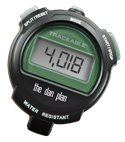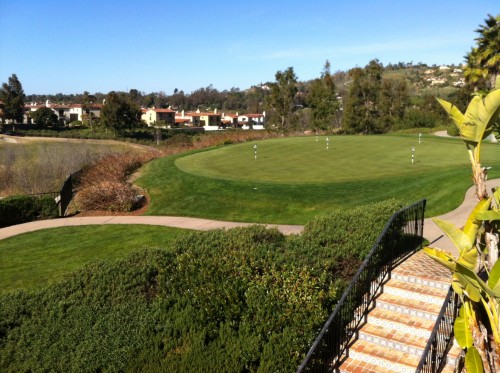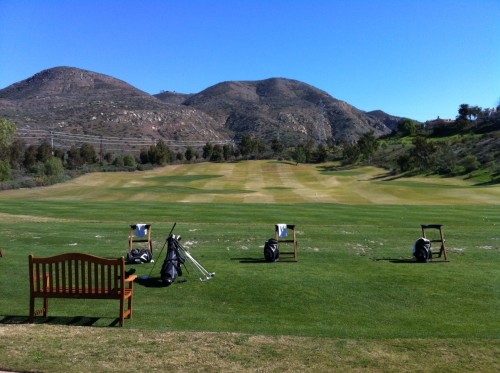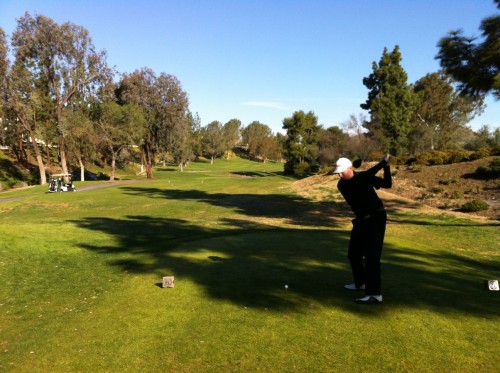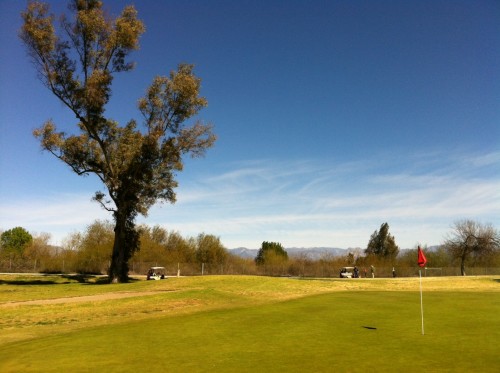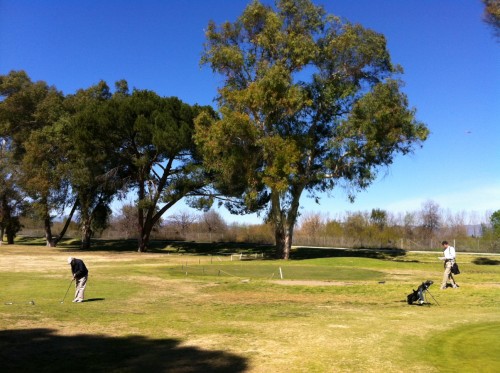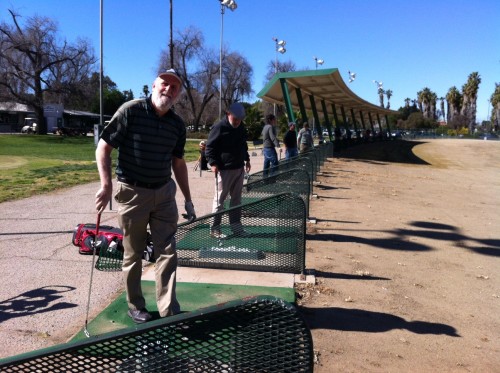California: the rest of the story
The day after my fitting experience I was invited to play The Crosby by a reader of the blog, Steve. I didn’t know it at the time, but I was in for a treat. Crosby National Golf Club is quite possibly the most challenging, different and aesthetically pleasing course I have played outside of Oregon. It is in perfect condition and nestled in the hills of Rancho Santa Fe, California:
And with a practice range like this I could spend a long long time here:
I could live on this range. The crazy thing was that there was a guy hitting balls next to me for a while complaining to his friend about the conditions of the grass. I suppose it’s all relative, but for me it was hard to imagine a more serene and well kept spot for hitting balls on this planet.
The round was out of this world compared to anything I have ever played. It was kind of a hybrid of desert and mountain golf with a lot of forced carries and fairways where both sides were OB because you couldn’t find your ball if it rolled off of the grass. A good bit of tee shots had interesting distances from the tees to the fairways, too:
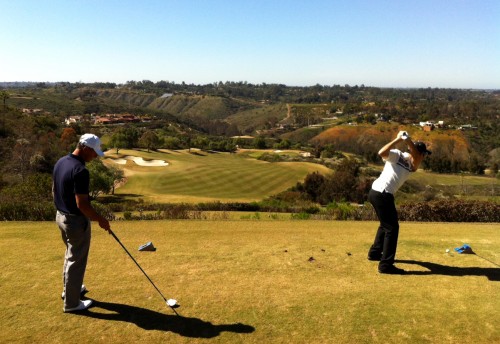
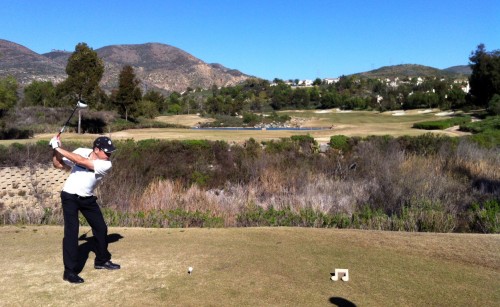 It was one of those courses where you were super penalized for missing a fairway and when your driver is not the most consistent stick in the bag you get hurt pretty often. When we headed out the starter warned us to bring a couple of sleeves of balls each and gave us an over-under of 7 lost balls for the round. Little did we know that we would each come close to losing 7 balls. Regardless of balls lost, it was an incredible round and I appreciate the invite to play. Check out this one last picture from the round:
It was one of those courses where you were super penalized for missing a fairway and when your driver is not the most consistent stick in the bag you get hurt pretty often. When we headed out the starter warned us to bring a couple of sleeves of balls each and gave us an over-under of 7 lost balls for the round. Little did we know that we would each come close to losing 7 balls. Regardless of balls lost, it was an incredible round and I appreciate the invite to play. Check out this one last picture from the round:
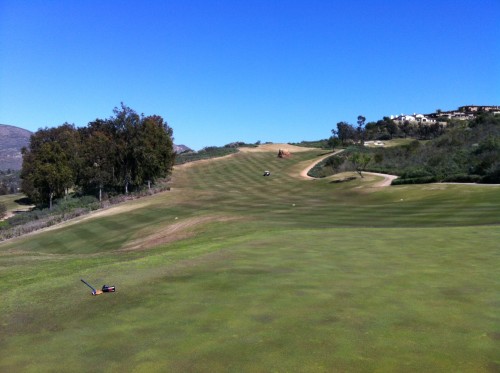 The hole played at 460 yards, but if you hit a drive to the right spot it would fly down the fairway and roll for ages leaving you with a short-iron in. If you hit the wrong spot the ball would get stuck in a little swell and you had a downhill lie with 200+ remaining. Driving was key.
The hole played at 460 yards, but if you hit a drive to the right spot it would fly down the fairway and roll for ages leaving you with a short-iron in. If you hit the wrong spot the ball would get stuck in a little swell and you had a downhill lie with 200+ remaining. Driving was key.
The next day I played a round at Rancho Bernardo Inn with a couple of the Titleist guys I met during the fitting day. It was again a picturesque day (which I think every day is in Southern California) and even though it warmed up to short sleeve weather we actually had a bit of a frost delay to start.
One of the gents was a lefty, Austin, and after they saw my drive on the first tee he suggested I play the rest of the round with his driver. To my surprise, I hit his club on the second hole and it had both a great trajectory and got about 20 more yards than I had been hitting. It was awesome! I felt like all of the hard work I had been putting in finally paid off and I was stoked to get to try out a new driver that was a bit of a better fit for my swing. By the end of the round I was sold, I had never driven the ball so well and am excited to see things start to really click off the tee.
After the round my Titleist contact, Dave, and I went to a driving range in Carlsbad to hit some balls and work out a few kinks and then I split town for a couple of nights in LA to meet with UCLA’s Dr. Bob Bjork, Harvard’s Dr. Dan Schacter and Sean, a Time Magazine profile writer. I was bummed that my time in Carlsbad had so quickly come to a close, but excited to meet the next group.
I met up with the the Docs and reporter for a round at the Encino Golf Course in NW LA. As it turns out, all of these guys were a pleasure to be around and we had a wonderful time playing two rounds over two days. Dr. Bjork is a Distinguished Research Professor in the Department of Psychology at UCLA who’s research focuses on human learning and memory and on the implications of the science of learning for instruction and training. Dr. Schacter is a Professor of Psychology at Harvard University. His research, according to Wikipedia, has focussed on psychological and biological aspects of human memory and amnesia. As you can imagine, I had a lot of questions for this learning power duo.
The day was perfect and the round a pleasure. Here is a photo from the first day:
At the beginning the wind was howling, but it calmed through the day, which ended up being literally the longest round that I have ever played and what Bob and Dan thought was the longest round they had ever played, which is pretty long seeing as they started playing together in 1979 a month before I was born. It was almost a 6 hour round and I suppose that is what you have to put up with if you try to tee it at 11am on a LA public course ![]()
Regardless, there was a ton to talk about so the time flew by. One of the main topics was interleaving practice. Interleaving is designing learning contexts in which learning is made more difficult during instruction, but retention and transfer are higher after a delay. For example, on a driving range you could either hit 20 balls with a 7-iron in a row or you could hit 20 balls using a different club and with a different target in mind each time. What Dr. Bjork’s research has found is that the latter method has much greater learning retention and is therefore a more efficient way to practice. It works with any type of learning, too. At a dinner later that evening with Dr. Bjork and his wife Elizabeth (who is also a Ph. D. in Cognitive Psychology and parters with Bob at UCLA’s Bjork Learning & Forgetting Lab) they talked about research they did with free throw shooters in basketball that found if you practice from random distances (8, 12, 9, 11, 10 feet, etc) instead of blocked practice from the free throw line there were increases in performance and learning. They are convinced that they could have made Shaq a better free throw shooter if they had been able to contact his coaches back in the day. I believe they would have.
For more info on interleaving, you can read one of Bob’s papers here: http://learninglab.uchicago.edu/Publications_files/5-CogsciIddeas2005.pdf The section on interleaving is on page 2.
We talked about my project quite a bit as the reporter was interested in how I was going about learning. My processes, it seemed, fit well with the research that the doctors had been doing. Since day one I have been conferring with different research and performance experts and have tried to implement all of the findings that I can. Sometimes, though, it’s hard to know if things are tracking in the right direction, and it was good to hear from these guys that they thought I had made some huge strides in my game. They were very encouraging and even invited me to attend ICHP (Interdisciplinary Conference on Human Performance) in St. George, Utah in March. It would be an incredible experience to be involved with this as it is 20 of the leading human performance research minds in the world gathering to talk shop and golf. I’m not sure if I will be able to attend as there just isn’t a budget for trips like this, but at some point down the road I hope to secure a sponsor for the project so these experiences are possible. If it does happen I will definitely report back on everything that is talked about during the conference and rounds.
Back to the rounds.. That’s Bob on the left chipping it to a foot for par and a 35 on the front and Sean from Time Mag on the right. It’s always good to have a gallery ![]()
Below is Dr. Dan smiling on the range before our first round:
Bob making a great 40 yard sandy up and down on the 9th hole of Encino. He played very well and was one under for the nine: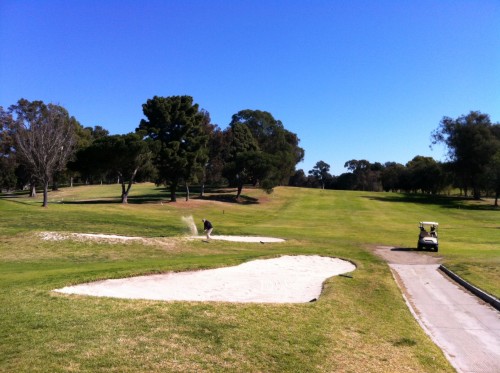
From day two at Rancho Park (which we teed it at 7am and played in 3.5 hours, a stark contrast to the middle day tee time on the previous round), this plaque below is great. I didn’t realize it, but this is the hole at Rancho Park in LA where Arnold Palmer shot a 12 on the first day of a tournament.
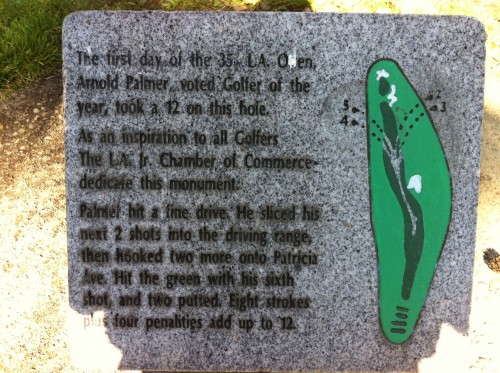 Luckily, I hit a good drive on the par 5 hole and knocked a 4 hybrid to 12 feet. The eagle putt came up short but I made it for birdie which put me at 79 for the round. I finally hit my goal of shooting in the 70s on the road at a course I had never played. That was definitely the only scoring highlight from the four rounds, the other three being in the mid to high 80s. Playing on the road in front of strangers who invite you out is a lot like playing in tournaments and it is something that can be worked on. Now that I know I can shoot in the 70s in these situations it should come more often and easier. Here is the approach shot on that par 5 where Arnold shot 12:
Luckily, I hit a good drive on the par 5 hole and knocked a 4 hybrid to 12 feet. The eagle putt came up short but I made it for birdie which put me at 79 for the round. I finally hit my goal of shooting in the 70s on the road at a course I had never played. That was definitely the only scoring highlight from the four rounds, the other three being in the mid to high 80s. Playing on the road in front of strangers who invite you out is a lot like playing in tournaments and it is something that can be worked on. Now that I know I can shoot in the 70s in these situations it should come more often and easier. Here is the approach shot on that par 5 where Arnold shot 12:
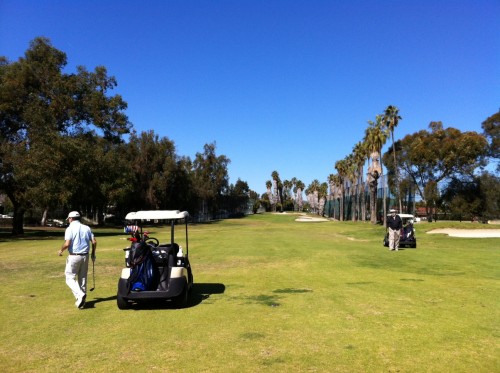 It was a great trip and I learned way more than I thought I would. From specifics about my gear to generalized knowledge on better ways to learn, this was five days very well spent. I’m excited to get back out to practice today and work on the game. Tournament season starts here in a couple of weeks and I am ready for it. Some words of wisdom that Bob said after our first round was that at first you have to go into tournaments expecting to fail, and when that happens you need to learn from it and you will improve each time. Like everything, it is a new experience and the point of these early tournament is to learn from them, not to go in expecting to win and frustrating yourself. Keep an open mind and learn everything you can each time. Keep moving in the right direction.
It was a great trip and I learned way more than I thought I would. From specifics about my gear to generalized knowledge on better ways to learn, this was five days very well spent. I’m excited to get back out to practice today and work on the game. Tournament season starts here in a couple of weeks and I am ready for it. Some words of wisdom that Bob said after our first round was that at first you have to go into tournaments expecting to fail, and when that happens you need to learn from it and you will improve each time. Like everything, it is a new experience and the point of these early tournament is to learn from them, not to go in expecting to win and frustrating yourself. Keep an open mind and learn everything you can each time. Keep moving in the right direction.

